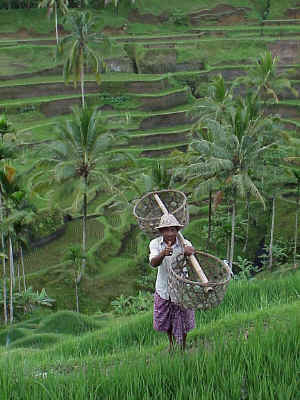|
| |
[ Up ] [ HOME ]
[ Cast System ] [ Cremation ] [ Music and Dance ] [ Religion ] [ Rites of Passage ] [ Special Days ] [ The Home ] [ Way of Life ]
Way of life
The People, the Village and Orientation
 |
Bali is a small island, it is only 140 kilometers (km) long and 80 km wide
and has a total area of 5620 square km. With a population of
about 3.5 million people it is a densely populated island.
Most of the population live in closely packed villages of 2000 to 4000
people on the fertile southern slopes of the island, the villages line the ridges that
also carry
the irrigation ditches and roads. On these
slopes it is usually only a fifteen minute walk from one village to the next
through the open rice-fields. On
the northern coastal strip, the villages are spread along the Java Sea.
Traditionally the social organization of the island was based on the
village with each village being a complete and self-sufficient unit, providing all needs
and functions from birth through life and then cremation.
Recently, as in all industrializing countries, the cities and tourist centers are
absorbing a drift of population from the countryside and centralizing to some
extent, the flow of goods and services. The
social organization of the villages is one of the most unique aspects of this island.
The village and the life of its members are closely tied to religion and
the religious life of the people.
|
Often in the center of a village
there is an ancient tree often a banyan, this tree is regarded as sacred and
believed to be the first tree on earth. In its branches or in
a special tower nearby, the village “kul kul” or wooden gong is held.
This kul kul acts as a warning of danger, tells of a death in the village or
calls the men to gather for a meeting of the “Banjar”.
Banjars play an important roll in the old and modern Bali culture.
A village may have several Banjars, with each Banjar having some separate
allegiance to a certain temple, places and holidays.
Even the bustling metropolis of Denpasar is rigidly divided into Banjars.
All decisions concerning the welfare and structure of its people are made by
the 100 percent agreement of all the married men in the Banjar.
The Balinese are aware that this means that new ideas take a long time to
be accepted but it keeps everything peaceful and holds the community together.
Each family has communal duties to perform for the Banjar so all feel that
they are a part and look after each other as a large family.
[ Back ]
[ Cast System ] [ Cremation ] [ Music and Dance ] [ Religion ] [ Rites of Passage ] [ Special Days ] [ The Home ] [ Way of Life ]
|
